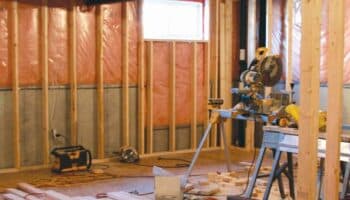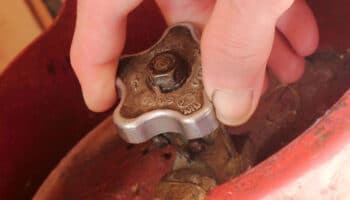We've independently reviewed this article to make sure it's as accurate as we can make it.
To find out more about our article creation and review process, check out our editorial guidelines.
Are you wondering what temperature to leave a vacant house in winter?
Leaving a house unoccupied for winter without heat can lead to different issues. So, it’s important to learn how to maintain the right temperature.
Luckily, you’ve come to the right place.
If you’re leaving a house vacant in winter, you’ll need to keep it between 50 and 55ºF to prevent water damage or frozen pipes. Protecting the plumbing, proper insulation, and the right thermostat setting will heat your empty house while keeping bills down.
Read on to learn more about the recommended temperature for empty houses in winter!
What’s the Ideal Temperature to Leave a Vacant House in Winter?
To keep your vacant house safe during winter, you must set a temperature of 50 to 55 degrees Fahrenheit.
To maintain the recommended temperature for empty houses, keeping your heater running high enough to stay efficient is important. I find that most home HVAC systems can effectively maintain a temperature of 55 degrees throughout your entire home.
Any lower than 55º and some heaters become less effective, which can lead to your home getting too cold and putting your plumbing at risk.
But, you want to keep your costs down. Energy costs to heat a home increase for every degree above (or below) the outdoors you want to maintain. From what I’ve seen, the smaller the difference between indoor and outdoor temperatures, the lower your heating bill will be. When it comes to heating a cold home, 55 degrees is a safe compromise between safety and cost-effectiveness.
How to Efficiently Heat an Empty Home
Heating your empty house efficiently in winter can be simple. You need to help it retain as much heat as possible and keep your HVAC system set low.
Read on to learn more about how to maintain the right temperature!
#1 Protect the Plumbing
If you’re leaving a house vacant in winter, ensuring your pipes are in good condition is crucial.
If you will be away for longer than a few weeks, I recommend turning off the water and draining the pipes completely. It’s easier to keep pipes from freezing if there’s no water in them, to begin with.
If you have hose spigots outside the house, insulate them or replace them with a frost-free hose spigot. I find that hose spigot covers can work, or you can also use old bundled towels covered with plastic. Just make sure everything is dry and sealed.
#2 Set the Thermostat
When leaving my house vacant during winter, I always set the thermostat to the right temperature.
In my experience, 55 degrees is safe in just about every house. Please ensure the heater is set to automatic, so it will kick in only when temperatures drop below the threshold, keeping your heating costs low.
If your thermostat allows you to set the fan, consider setting it to low but constant to keep humidity from building up in any one room. So, even with an unusually warm day, you won’t face humidity and condensation problems.
#3 Keep Things Airtight
If you’re leaving a house unoccupied for winter, you must also insulate it properly.
You see, when an empty house is leaking air, the heating bills will be sky-high no matter what.
Insulating the house properly will help keep bills down since you won’t be losing as much heat or cooling to the outside.
You don’t have to tear out walls or anything to insulate your home. In fact, I often tell homeowners that focusing on the worst air leaks will be enough to save them money.
- Seal Doors. If your house will be empty for a while, consider replacing the weatherstripping on outside doors to keep heat from escaping through cracks and gaps. You’ll also need to recaulk around older exterior doors. (This is a great idea even if the house isn’t vacant!).
- Seal Windows. Plastic film insulation is a simple way to seal off your windows. You can find purpose-specific window film at the hardware store. You can also use plastic cling wrap and tape if you have just a few windows you want to cover. Also, like doors, I find that older windows can benefit from some recaulking around the frame. So, if you see cracks or feel a draft around the window, you should probably seal it.
- Close Vents. Open vents let your heating budget fly right out the door. Close any vents that lead to the outdoors, including oven vents, dryer vents, ventilation fans, and anything else that sends air outside.
If you remember the tips above, your vacant house will stay warmer all winter.
Can You Leave a House Unheated in the Winter?
It can be tempting to leave your vacant house in winter to its own devices. After all, no one is there to complain about the cold.
However, the cold will leave its mark, especially if you live in a cooler climate. Problems can start to crop up as early as autumn.
Cold temperatures cause three main problems for unheated homes:
- Frozen pipes
- Flooding
- Humidity and water damage
Unheated homes naturally wind up at the same temperature as the outdoors over time. Even the best-insulated home will slowly cool down as winter sets in. Heat can slowly escape through cracks, vents, and even solid walls. The result is a house that can’t protect its plumbing anymore.
When your pipes get too cold, you’re faced with the possibility of frozen pipes, which can lead to cracked pipes.
My usual advice for preventing cracked pipes is to keep them from getting too cold. Heating your home enough to keep the plumbing in the walls above freezing is the simplest way to prevent the problem.
Even if your pipes don’t freeze or crack, cold temperatures can lead to humidity problems. Vacant homes are typically sealed up tight against the elements. If you aren’t maintaining your home’s temperature, the seal causes two issues.
First, any humidity inside the house is trapped. There’s nowhere for the moisture to go, so it will hang around, causing problems.
Second, even in the winter, temperatures can fluctuate. Sunny days can heat up your home slightly. If you’ve ever stepped into a car on a sunny day and found the inside scorching hot, it’s the same principle. Your house may not get that warm, but it will certainly become warmer than the great outdoors.
So now you have a humid, warm space separated from the frigid outdoors. Have you ever seen condensation on a cold glass of water on a hot day? That’s what your house’s windows and exterior walls will look like.
Condensation can lead to serious water damage near doors and windows, including mold, mildew, and rotten frames.
So, heating your vacant house in winter can prevent different issues.
Wrapping Up: Heating Your Vacant House in Winter
Hopefully, now you know the recommended temperature for empty houses in winter and different ways to maintain the heat.
Remember that if you’re leaving a vacant house in winter, keep it at a stable 55 degrees. It’s important to insulate your home before you leave and set the thermostat to prevent frozen pipes, flooding, and humidity.
I hope this article has helped you safely heat your vacant home. If it’s made your life a little easier, why not support us by checking out some of our other posts?
Thanks for reading! Have a great day.
-Craig






